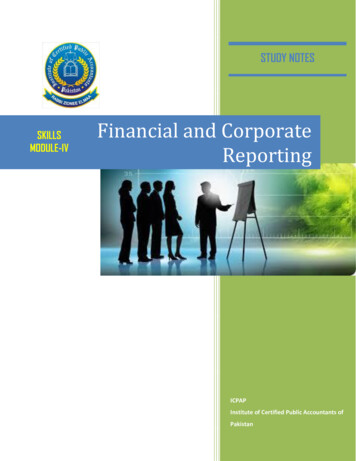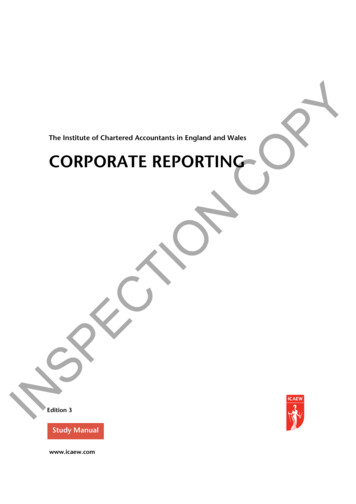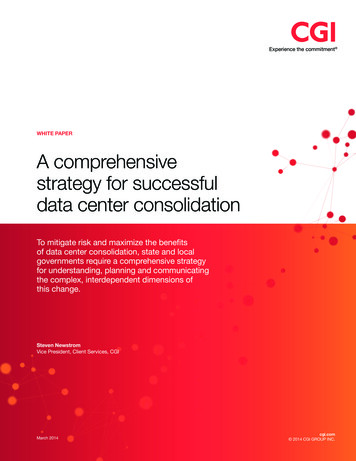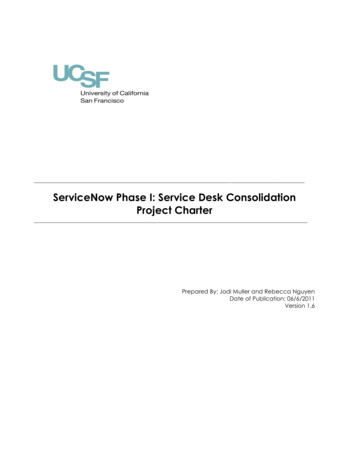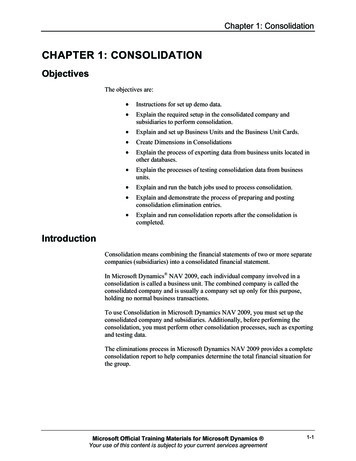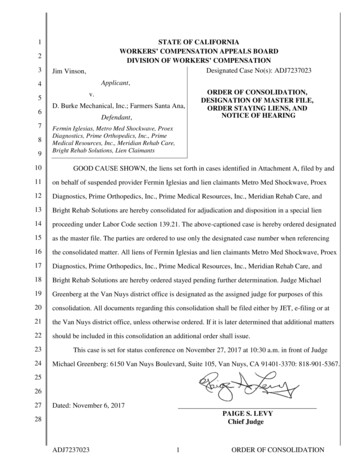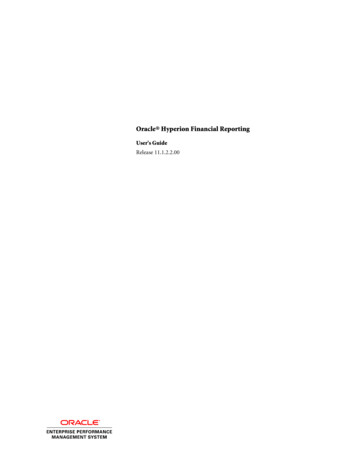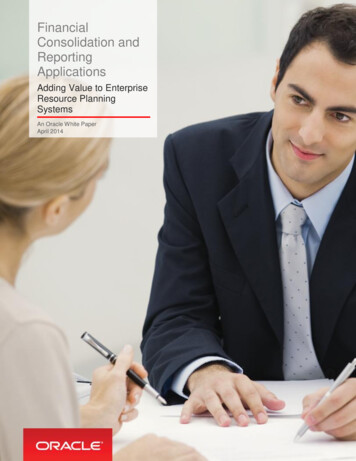
Transcription
FinancialConsolidation andReportingApplicationsAdding Value to EnterpriseResource PlanningSystemsAn Oracle White PaperApril 2014
Table of ContentsExecutive Overview . 3Introduction . 4Financial Consolidation and Reporting Requirements. 5Statutory Reporting. 5Management Reporting . 6Approaches to Financial Consolidation and Reporting . 8What is a Best Practice? . 9Adoption of New EPM Technology Improves Performance . 9What Functionality is Included? . 9Enterprise Resource Planning Systems . 11General Tools . 13Spreadsheets . 13Data Warehouses . 13Financial and Enterprise Performance Management Solutions . 14Packaged Solutions and the Fast Close. 17Integrate . 17Improve Accessibility . 17Improve Efficiency . 18Maximize Information . 18Integrating Financial and Transaction Systems . 19Adding Value to Multiple Enterprise Resource Planning Systems . 19Adding Value to Single Enterprise Resource Planning Systems . 21Transitioning to a Single Enterprise Resource Planning System . 22Customer Success Stories . 23The ‘Extended’ Financial Close . 24Conclusion . 25Financial Consolidation and Reporting Applications:Adding Value to Enterprise Resource Planning Applications 2
Executive OverviewToday’s corporations continue to face a vast range of complex financial reporting requirements, andever-increasing scrutiny by auditors and stakeholders. While transaction systems such as enterpriseresource planning (ERP) systems typically have general ledger modules that summarize results atperiod-end, ERPs on their own are not adequate to support the extended financial close process.Financial consolidation and reporting applications add significant value by enabling flexible, accurateand rapid reporting, and integrate easily with any ERP system. Financial consolidation and reportingapplications are a key component of the extended financial close – enabling an integrated andstreamlined process - all the way from the recording of transactions through periodic regulatory filing.Financial consolidation and reporting applications automate the extended financial close acrossmultiple hierarchies and include support for all of the special calculations required by US-GAAP, IFRSand other regulatory reporting standards. See figure 1 below.Figure 1: The Extended Financial Close Process.Financial Consolidation and Reporting Applications:Adding Value to Enterprise Resource Planning Applications 3
IntroductionFinancial reporting requirements come from a variety of sources and are both complex, and everchanging. Regulatory scrutiny has never been higher—especially as a result of the Sarbanes-OxleyAct (SOX) in the United States and International Financial Reporting Standards (IFRS 2005) inEurope. There are various approaches and software packages that can help companies automate theextended financial close. Of these options, packaged financial consolidation and reporting applicationswith purpose-built features will deliver the highest return on investment by improving the speed andquality of the financial close. To deliver the most value, the finance or accounting staff that compileand create the financial reports should be able to administer and maintain the financial consolidationand reporting application.Financial consolidation and reporting applications deliver a consolidated ‘book of record’. They provideaudit trails and permanent storage of the consolidated results so that internal and external auditors cantest and verify data. But financial consolidation and reporting applications also help organizations withmanagement reporting, a process by which companies examine and analyze information aboutbusiness performance to plan for change. Furthermore, these applications can help with performancestatistics that may be non-financial in nature, for example headcount, inventories, andsustainability metrics.Financial consolidation and reporting applications are part of most enterprise performancemanagement (EPM) solution suites. These solutions complement and integrate with various underlyingtransaction systems, including ERP systems. The applications that comprise an EPM system providecomprehensive support for the entire management cycle of goal setting, modeling, planning,monitoring, analysis, and reporting. Part of the Oracle’s EPM system, Oracle Hyperion FinancialManagement can be run independently to address this particular segment of the management cycle.But when it is integrated with all the modules of Oracle’s enterprise performance management system,it supports an efficient, closed-loop EPM process that improves business insight and generates betterbusiness decisions.Financial Consolidation and Reporting Applications:Adding Value to Enterprise Resource Planning Applications 4
Financial Consolidation and Reporting RequirementsFor most publicly traded companies, it is challenging to aggregate historical results in monthly orquarterly reports. One of the greatest challenges is meeting the business requirements for bothstatutory / legal and management reportingStatutory ReportingStatutory reporting refers to the financial reporting that helps regulate public companies listed on theworld’s stock exchanges and the accompanying requirements detailed by governmental bodies such asthe U.S. Securities and Exchange Commission. This is typically a quarterly reporting requirement.Statutory requirements come from many sources: The Financial Accounting Standards Board (FASB). The FASB publishes U.S. financial accountingand reporting requirements The International Accounting Standards Board (IASB). The IASB publishes International FinancialReporting Standards (IFRS) and International Accounting Standards (IAS) in Europe andother countries Government. Accounting rules can come directly from local governments or stock exchanges, such asJapanese statutory requirements that must be complied with for listing on the Tokyo Stock Exchange Regulated industry. Companies in regulated industries, such as banking, insurance, and utilitiestypically have special statutory accounting and reporting requirements Tax authorities. All companies must comply with local tax authorities. For example, U.S. companiesmust comply with Internal Revenue Service requirementsAll these requirements can be broadly defined as statutory or ‘required by the state’. Failure to complywith statutory requirements can cause delisting from public stock exchanges and severe penalties. Also,although these requirements apply to all publicly traded companies, they are often adopted by privatecompanies and not-for-profits as well.Most financial accounting standards deal with the what, when, and how of recording transactions. Forexample, the FASB’s ASC605 and IASB’s IAS 18 describe when to recognize revenue; ASC850 / IAS 24describes what should be disclosed in related-party transactions such as those between owners andmembers of their immediate family.There are actually very few consolidation and reporting-related accounting standards, but they aresometimes the most difficult and complex. The overriding principles of consolidation reporting were setforth more than 50 years ago in Accounting Research Bulletin (ARB) 51.Financial Consolidation and Reporting Applications:Adding Value to Enterprise Resource Planning Applications 5
ARB 51 states the following: “The purpose of consolidated statements is to present, primarily for thebenefit of the shareholders and creditors of the parent company, the results of operations, and thefinancial position of a parent company and its subsidiaries essentially as if the group were a singlecompany with one or more branches or divisions”.To achieve the purpose of consolidated financial statements, those statements must report as faithfully aspossible the results of operations, cash flows, and the financial position of a reporting entity thatcomprises a parent and its subsidiaries. Underlying that purpose is the investors’ need for relevant,reliable, and comparable financial information that is helpful to them in assessing an entity’s financialposition and performance. The reports must present the information so investors can compare it withreports for other periods and with similar information about other entities. A fair assessment of acompany’s performance relies on information about all the activities related to the economic resourcesthat an entity controls.ARB 51 further states the following: “There is a presumption that consolidated statements are moremeaningful than separate statements and that they are usually necessary for a fair presentation whenone of the companies in the group directly or indirectly has a controlling financial interest in theother companies”.The most common ASCs / IASs related to consolidation include ASC205 / IAS 27: Presentation of Financial Statements ASC810 / IAS 27: Consolidation of Majority-Owned Subsidiaries ASC830 / IAS 21: Foreign Currency Transactions and Translations ASC230 / IAS 7: Statement of Cash Flows ASC280 / IAS 14: Disclosures about Segments of an Enterprise ASC740 / IAS 12 Accounting for Income TaxesFor today’s diverse, global organizations, complying with statutory requirements can be a dauntingtask. Without robust consolidation and reporting processes, complying with multiple external reportingrequirements becomes difficult, if not impossible.Management ReportingExternal or statutory reporting differs from internal or management reporting. A company’s managersset management reporting requirements, and the information is not typically disclosed to governmentsand third parties. Management reporting requirements are usually different for distinct organizationallevels and the reports tend to be more analytic than statutory reports. For example, detailed budgetvariance analysis, an intrinsic element of management reporting, is not required for statutory reporting.In addition, management reporting typically determines incentive-based compensation. Generatingsuch reports gets complex when a company bases compensation for its management team on factorsfor which there are no guidelines in the generally accepted accounting principles.Financial Consolidation and Reporting Applications:Adding Value to Enterprise Resource Planning Applications 6
In addition to management reporting on revenues, profits and cash flow, a company typically needs totrack key performance statistics that may be non-financial in nature, for example headcount,inventories, and sustainability metrics. Some of these key statistics may be reported externally andsome may not. For example, some companies voluntarily disclose hiring trends in their sales force.Others may report on energy and water usage, recycling, or other sustainability metrics. For others,inventory surpluses or shortages are important metrics that shareholders have an active interest in1evaluating. A recent Accenture and Oracle Study shows the percentage of non-financial data neededfor regulatory filings is on the rise.Figure 2: Percentage of non-financial data needed for regulatory filing1The Challenge of Corporate Reporting Research Study carried out by Dynamic Markets on behalf ofOracle and Accenture. 2012Financial Consolidation and Reporting Applications:Adding Value to Enterprise Resource Planning Applications 7
Approaches to Financial Consolidation and ReportingThere are three basic approaches to financial consolidation and reporting: Packaged or ‘best-of-breed’ financial consolidation applications ERP systems General toolsThese primary approaches were identified in a study by BPM International. In 2011, BPM Internationalsurveyed 99 of the largest corporations in the world across all industries to identify common traits oftop-performing finance departments. The study found that 81 percent of survey respondents usedpackaged financial consolidation applications, while 25 percent used an ERP system. The remaining 122percent used general tools, such as spreadsheets and data warehouses. (Note: respondents wereable to select more than one option which is why the total percentage is greater than 100%)2European EPM Study - Enterprise Performance Management 2011 and Beyond. 2012 BPM International. All rights reservedFinancial Consolidation and Reporting Applications:Adding Value to Enterprise Resource Planning Applications 8
What is a Best Practice?Adoption of New EPM Technology Improves PerformanceIn this study by BPM they commented: “Compared to our study in 2007, the use of EPM software /technology has increased. Looking at the top performers, it is clear that the use of EPM specialized toolsis helping them to support the different close processes. From the Top 20 companies 80% haveimplemented EPM software in their organization. The bottom performers didn’t manage to automate thedata collection process – 60% are still entering data in local reporting packs and Microsoft Excel sheets.”What Functionality is Included?Oracle Hyperion Financial Management is classified as a packaged best-of-breed financial consolidationand reporting application. For a software solution to be classified this way, it must do all of the following: Structure and automate. Typically used by finance teams in midsize-to-large publicly tradedcorporations, financial consolidation and reporting applications structure and automate the monthly orquarterly aggregation of historical results. These applications embed rules, procedures, and techniqueswith an accompanying methodology, fulfilling specific statutory / legal reporting requirements associatedwith the period-end financial close. Such standards include the GAAP and the IFRS. Support management reporting. Financial consolidation and reporting applications allow users toanalyze information about the business and help to plan for change, a process collectively known asmanagement reporting. Financial consolidation and reporting applications perform functions that are adhoc, involve creativity, and address what-if scenarios. They allow companies to: Analyze unique events such as modeling a new corporate structure, revising the existing corporatestructure, starting a new division, and planning tax and treasury strategies for acquisitions anddivestitures Evaluate profitability by product, brand, and customer segment Determine compensation for a sales or management team based on any factor of performance; forexample, financial consolidation and reporting applications can support reporting for companies thatcompensate salespeople based on the sales they booked during a period, rather than the revenue theygenerated for that period Collect and consolidate the environmental and social metrics often included in sustainability reporting,as well as other nonfinancial information that is required for internal and external reporting. This is anincreasing trend according to the recent Accenture and Oracle Study Act as a consolidated book of record. Financial consolidation and reporting applications mustprovide audit trails and permanent storage of the consolidated results for internal and external auditorsto test and verify data. Financial consolidation and reporting applications also provide controlmechanisms to ensure that statutory / legal and management reporting is complete and accurate. Aspart of their annual internal control evaluations, public accountants rigorously audit companies’ financialconsolidation and reporting applications and the data generated.Financial Consolidation and Reporting Applications:Adding Value to Enterprise Resource Planning Applications 9
Not require IT administration. To deliver the most value, the finance or accounting staff that compileand create the financial reports should administer and maintain the financial consolidation and reportingapplication. Furthermore, end users outside finance—for example, operational revenue and cost centermanagers—should be able to customize and create their own reports, thereby promoting a ‘self-service’operating model. Because of their packaged and self-service features, support of financial consolidationand reporting applications requires fewer staff members than any of the other mostcommon approaches.Figure 3: How organizations deal with sustainability reporting – 34% have completely integrated themFinancial Consolidation and Reporting Applications:Adding Value to Enterprise Resource Planning Applications 10
Enterprise Resource Planning SystemsThe second most common choice is to consolidate financial results within the ERP system itself. With thisapproach, general ledgers or data warehouse technologies consolidate the results within the ERPtechnology stack. The primary advantage of this approach is that financial consolidation is fully integratedwith the underlying transaction systems. However, financial consolidation can only be fully integratedwhen all underlying transaction systems are from the same vendor and they are installed as a singletechnology stack. For example, figure 4 shows the recommended architecture for customers who haveOracle’s PeopleSoft transaction systems.Figure 4: A combined ERP and EPM solution relies on same-vendor architectureThe biggest issue with the ERP approach is the difficulty coping with organizational change. Changes tothe chart of accounts and entity structures must be scrutinized and implemented by IT professionals asthey are pervasive across the entire ERP system. The general ledger often makes it difficult toconsolidate data from multiple periods, evaluate restatements, analyze what-if scenarios, or reconcilediffering methods of recognition and reporting associated with management reporting. As a result, thefinance department must complete these tasks offline in a spreadsheet because they can’t afford to waitfor IT to respond. In general, only companies with limited environmental change can succeed for asustained period with this approach. Also, ERP consolidations require the largest dedicated staff.Financial Consolidation and Reporting Applications:Adding Value to Enterprise Resource Planning Applications 11
How big an issue is change management? In the recent Oracle / Accenture study, a large majority ofcorporations have made substantial changes to the three phases of the extended financial process in thelast 3 years. (In the study the three phases were defined as 1-closing, 2-reporting and 3-filing –see figure 1) And the pace is expected to increase.Figure 5: Changes made to the three phases of the extended financial close process over the last 3 years.Financial Consolidation and Reporting Applications:Adding Value to Enterprise Resource Planning Applications 12
General ToolsGeneral tools, including spreadsheets and data warehouses, were used by approximately 12 percent ofcompanies in the BPM International study.SpreadsheetsWhen the spreadsheet approach is used, spreadsheet templates are created by central headquarters ande-mailed to remote locations. Then, on a monthly or quarterly basis, these spreadsheets are updated ande-mailed back to central headquarters, where they are consolidated into a master spreadsheet— usuallywith complex ‘macros’. The only advantage of this approach is low cost because there is no software orhardware to buy. Everyone in the organization already has e-mail access and a spreadsheet applicationon their desktop.The biggest disadvantages of this method are, that it is difficult to maintain the spreadsheets, and there isno audit trail. It can be very difficult to keep all the spreadsheets updated and synchronized, especially inan environment of persistent change. Errors happen frequently and are difficult to correct, as there is noaudit trail of adjustments or changes to the spreadsheets. Finally, specialized knowledge is required toprogram the spreadsheets, making companies fully dependent on one or a few spreadsheet ‘gurus’.Though a spreadsheet can help with statutory and management reporting when used with a financialconsolidation and reporting application, standalone spreadsheets are being increasingly rejected asacceptable financial consolidation and reporting tools by public auditors during their internal controlreviews—particularly those audits in the United States required by SOX.Data WarehousesThe generic data warehouse is an IT-intensive approach. Indexed and coded data is loaded from generalledgers into a generic relational or multidimensional data storage system. The system then performscalculations and allocations and generates output reports. The primary advantage of this approach is itscustomization capability, because any number of unique calculations can be created. The primarydisadvantage is that, because data warehouses are typically IT projects and not owned by the financeteam, this method requires dedicated programming expertise. IT will be required to create and maintainthe system and to oversee certain aspects, such as reporting formats and security. As such, delays andinflexibility are constant challenges.Furthermore, external auditors will usually want to review any custom system used for financialconsolidation and reporting in detail, but will not require as extensive an audit when a familiar packagedfinancial consolidation and reporting application is used. This is because the financial consolidation andreporting application has software controls auditors are familiar with from their broader experience acrosstheir customer-base. Generic data warehouse approaches will often increase audit fees and couldincrease internal control risk as well.Financial Consolidation and Reporting Applications:Adding Value to Enterprise Resource Planning Applications 13
Financial and Enterprise Performance Management SolutionsStandalone financial consolidation and reporting applications are very effective in streamlining financialconsolidation and reporting when implementing a complete EPM solution is not practical. But a modularsuite of applications integrating financial consolidation and reporting, and other EPM applicationsprovides the most comprehensive support for the entire management cycle of goal setting, modeling,planning, monitoring, analysis, and reporting with the fastest time to benefit (See figure 6). Financialconsolidation and reporting applications are important components of EPM, enabling customers to linkstrategies to plans, monitor execution, and gain insights to help manage and improve performance.These applications can be used independently to address the financial consolidation and reportingsegment of the management cycle, but together they support a closed-loop EPM cycle.Figure 6: The Oracle Enterprise Performance Management System supports the compete management cycleAs shown in figure 7, a robust financial consolidation and reporting application brings together trialbalances and other information from one or many general ledger, ERP or other transaction systems.Actual results from one or many transactional general ledger / ERP systems will typically be loaded orintegrated into financial consolidation and reporting solutions at the period end. Once the consolidationprocess is complete, reports and dashboards can be accessed through a web browser or Microsoft Officeuser interface.Financial Consolidation and Reporting Applications:Adding Value to Enterprise Resource Planning Applications 14
Figure 7: A robust financial consolidation and reporting solution integrates information from multiple transactional systemsAs part of a robust EPM framework, financial consolidation and reporting applications should supportthe following financial processes: Management, legal, and tax reporting Complex currency translations Intercompany and minority interest eliminations Complete audit trails Journal adjustments Multidimensional analysis Cash flow reporting Tax provisioning Extensible Business Reporting Language (XBRL) reporting Reporting key performance statistics that are non-financial in nature (these could include sustainabilityreporting following Global Reporting Initiative (GRI) guidelines, for example)Financial Consolidation and Reporting Applications:Adding Value to Enterprise Resource Planning Applications 15
They should also include the following features: Prepackaged features that can be used quickly and cost-effectively Flexible business rules and powerful allocation rules that help in cost accounting and are easily setby staff Robust data integration with legacy applications and transaction systems Graphical drag-and-drop data mapping and administration of the chart of accounts anddimensional hierarchies Productivity features that can help trim days and weeks off the close cycle and support fast closebest practices Preventive financial control mechanisms and sophisticated process management with automatic email alerts End-user–defined line item details and text messages for added analysis and collaboration Nested dimension forms with drill-and-pivot features for navigation ease Reports and graphics that are high volume and preformatted Built for the Web functionality for ease of use; no PC client installation for end users Around-the-clock availability of mission-critical data Inherent integration with all leading security mechanisms Failover and load-balancing technologies Best Practice Starter Kits for special reporting requirements – Solvency II, Sustainability Reporting(GRI), IFRS etc.Financial Consolidation and Reporting Applications:Adding Value to Enterprise Resource Planning Applications 16
Packaged Solutions and the Fast CloseFinancial consolidation and reporting applications are often implemented as part of an effort to speed thecompany’s financial close and reporting cycle. Why is a fast close so important? From an externalperspective, speedy and high-quality financial reporting is an indicator of good governance and is viewedfavorably by investors. Internally, management will always want to know how business strategies are trackingagainst expectations as soon as possible. A faster close maximizes the time available for managers toanalyze strategies and possibly alter them.As mentioned earlier, the BPM International study found that financial consolidation and reportingapplications were used more often by the best-performing finance departments (80%). But, how fast is fast?According to the BPM International study:“On average subsidiaries need 12 working days to finalize their financial close and report to the corporatecentre, the fastest subsidiaries manage to send their financial results in only 2 working days. Consolidation ofthe results needs on average 10 working days, so after 22 working days the management at group level get’sthe first consolidated results presented. Looking at the fastest company in our study we see a big gap. Thiscompany is ready and finished the reporting on working day 3 and has full insight in the financial performanceof the group.After the first consolidation and internal reporting to the management companies need another 15 workingdays to publish or announce their results to the market or shareholders. This is not the full annual financialreport with the audit signature. On average groups need another 34 working days to prepare and publish theannual report, the fastest participant publishes the annual report after 10 working days, so they are finishedafter 16 working days and can focus on the financial performance of the group in the New Year.”How do companies achieve world-class financial close performance? The fastest-c
Financial reporting requirements come from a variety of sources and are both complex, and ever- . Financial consolidation and reporting applications deliver a consolidated ‘book of record’. They provide . Most financial accounting standards deal wi
